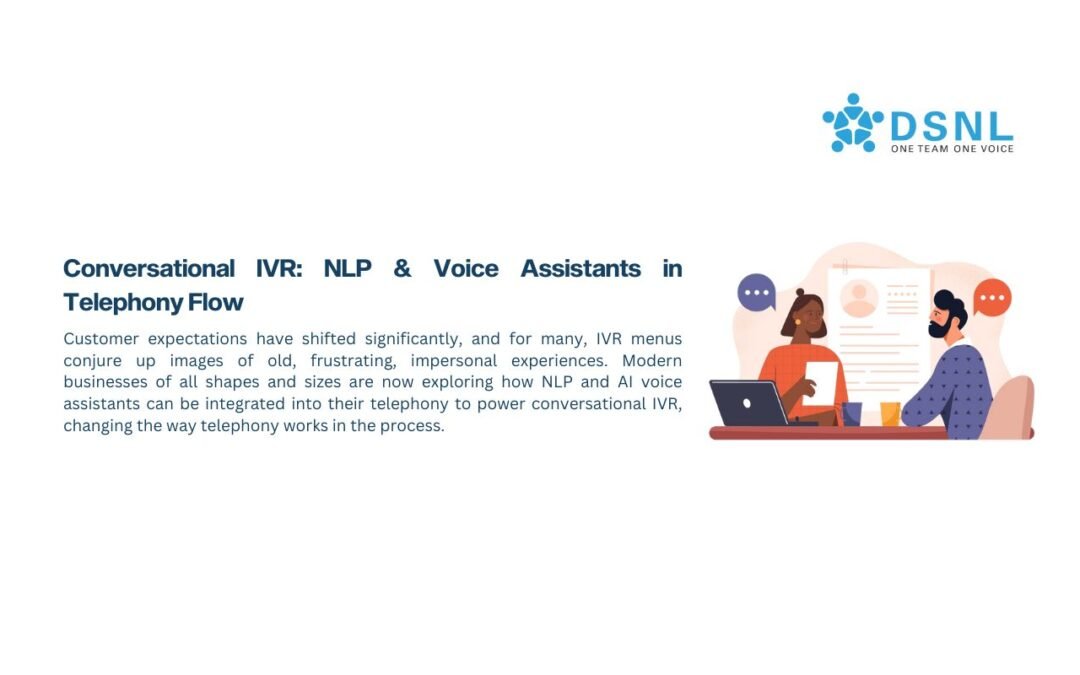Customer expectations have shifted significantly, and for many, IVR menus conjure up images of old, frustrating, impersonal experiences. Modern businesses of all shapes and sizes are now exploring how NLP and AI voice assistants can be integrated into their telephony to power conversational IVR, changing the way telephony works in the process. Conversational IVR will allow businesses to add natural, intuitive conversations to their business voice systems and shift how callers interact with and across automated systems.
Introducing natural language processing (NLP) to IVR: AI for Telephony
In the context of NLP for telephony, natural language processing and will be responsible for capturing the caller’s speech input and extracting the intent, or meaning, from it. The natural language processing will also manage the context of the conversation as well as delivering the desired response to the caller. The natural language processing aspect of voice systems is built to cope with variances in speech, accents, phrasing, intonation, and even levels of background noise.
Natural language processing for telephony enables businesses to have voice interactions with customers that are far more flexible and far more personalised. Callers don’t need to be locked in by the limited set of options defined by pre-recorded scripts. Instead, callers can ask, say, or enquire about whatever they want, in any order they like, and the NLP model can intelligently process what they say and provide dynamic, customised responses in return. Natural language processing models for speech can also be custom trained on historical caller data to improve accuracy, minimise errors, and optimise the overall user experience.
Chatting with a smart voice assistant: Intelligent Agents for Voice
Voice assistants take the power of conversational IVR one step further by adding a powerful additional layer to the telephony automation. Voice assistants sit in the middle as an intelligent agent between the caller and the service backend, with a singular purpose of understanding the caller’s requests, conversing in natural language, and being able to access business systems to take action and/or fulfil business processes. The difference between a standard IVR and a voice assistant is that, while IVR only routes calls or plays back recorded messages, voice assistants converse and can offer a higher degree of intelligence.
Voice assistants are used to do a wide range of tasks, from booking appointments and providing account balance updates to answering FAQs and verifying a caller’s identity. In high-volume, low-value environments, voice assistants take on some of the burden of high-volume workflows from human agents.
Flow with logic: Building Intelligent Call Flows
Another big win for Conversational IVR is its ability to enable intelligent call flows. Traditional IVR calls flows tend to follow a rigid step-by-step menu structure. Intelligent call flows with Conversational IVR are dynamic and adapt on the fly to the way that the caller answers and interacts with the system. Intelligent call flows are critical for Conversational IVR, as call flows are what power the user’s call journey.
Crafting intelligent call flows requires planning and design, voice design, workflow design, and business system integration. Voice assistants for business don’t need to be generic or flat. They can be contextually aware, highly personalised, and smart enough to adapt in real-time to the way that customers change and develop.
Conclusion
Talk is cheap unless you use Conversational IVR. As these AI-based technologies mature, conversational IVR will become an increasingly important and central part of any unified comms strategy, with highly-tight integrations to CRM systems, cloud communications platforms, and analytics backends.
Talk to us today to explore how your business can start using modern NLP, Conversational IVR, and intelligent voice assistants.

